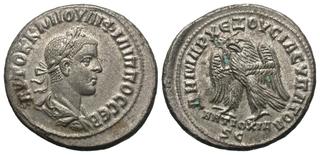This record is provided by CoinArchives, a database of numismatic auction catalogs.
Important copyright information:
The data below is presented by permission of the copyright holder(s). Reproduction is allowed only by authorization from VAuctions.
Important copyright information:
The data below is presented by permission of the copyright holder(s). Reproduction is allowed only by authorization from VAuctions.
| VAuctions > Triskeles Sale 26 | Auction date: 7 December 2018 |
| Lot number: 502 | |
| Lot description: Syria, Seleucis and Pieria. Antiochia ad Orontem. Philip II. A.D. 247-249. BI tetradrachm (27 mm, 11.64 g, 6 h). Cos. IV of Philip I (A.D. 248/9). AVTOK K M IOVΛI ΦIΛIΠΠOC CЄB, laureate, draped, and cuirassed bust of Philip II right / ΔHMAΡX ЄΞOVCIAC VΠA TO Δ, eagle, wings displayed, standing left, holding wreath in beak; in exergue, ANTIOXIA/S C in two lines. McAlee 1043; Prieur 473. Choice extremely fine. There appears to have been confusion at the mint of Antioch regarding Philip's consulships. That is, there is no historical record of of a fourth consulship for Philip I, only three, yet some of his tetradrachms are dated Cos. IV (since both Philip's wife and son also dated their coins from Antioch according to his consulships, this enigma presents itself on their coinages as well, as seen in the specimen offered here). The confusion possibly stems from a hiatus the Antioch mint took during A.D. 246, when either the Rome mint struck tetradrachms for Philip I, or dies produced at the Rome mint were used (McAlee series 3, with reverse MON VRB/S C and stylistically distinct from Philip's other Antiochene coinage). Upon restarting production in 247, the Antioch mint wrongly assumed Philip had celebrated a second consulship in 246, thus explaining the presence of the Cos. IV tetradrachms. If this theory is correct, we should view the reverse legend ANTIOXIA/S C as the mint mark, meaning "Antioch mint,"" and the legend of the previous series, MON(eta) VRB(is), meaning ""Roman mint.""" Estimate: 200 USD |  |


